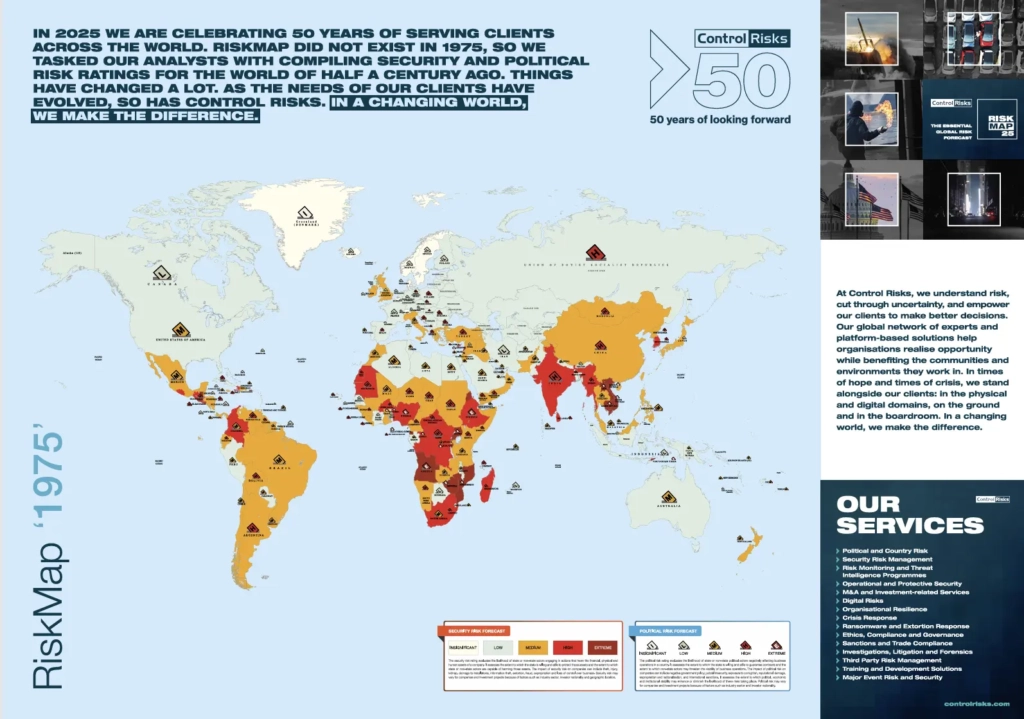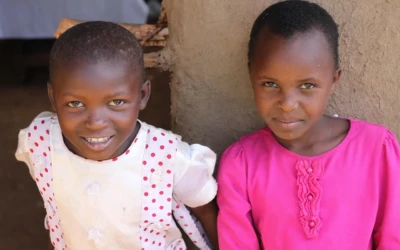Each year, Control Risks releases Risk Map, a comprehensive analysis of the key global risks impacting businesses and organizations. In 2025, geopolitical instability, economic strain, and the escalation of cyber threats are reshaping global security priorities.
This edition examines political, security, economic, cyber, and environmental risks, assigning each country a risk rating on a scale from 1 to 10. This structured approach enables businesses and other stakeholders to better anticipate potential threats and make informed decisions to safeguard their operations and personnel.
Global hotspots in 2025
The “hotspots” identified in this analysis are based on trends observed in Control Risks’ reporting and current global developments. They highlight the key risk areas anticipated for 2025.
Middle East: Escalation of the Israel-Palestine conflict
The Israel-Palestine conflict has escalated to unprecedented levels of violence, triggering significant regional repercussions. Intensified hostilities in the West Bank and Gaza are impacting economic stakeholders and disrupting key trade routes throughout the region.
Europe : the war in ukraine and russia’S shadow
The ongoing war in Ukraine continues to redefine Europe’s security architecture. As of 2025, combat has intensified on multiple fronts, while Russian-sponsored cyberattacks targeting European energy and logistics infrastructure have surged. Businesses are increasingly exposed to hybrid threats that combine cybersecurity vulnerabilities with conventional military risks.
Russia: Growing domestic instability
Despite remaining a central player in the conflict in Ukraine, Russia is grappling with significant internal turmoil. The sustained impact of international sanctions, a large-scale exodus of skilled professionals, and mounting social unrest are severely straining the economy. In 2025, Russia is classified as a high-risk country receiving the maximum score of 10 on the Control Risks scale due to its increasingly volatile political environment.
Africa: Political Instability and Persistent Security Threats
Across the African continent, several regions continue to face acute political and security challenges:
- Sahel (Mali, Niger, Burkina Faso): A series of military coups combined with recurrent jihadist attacks have rendered the region increasingly volatile, posing severe risks for both companies and NGOs operating on the ground.
- Ethiopia & Eritrea: Heightened diplomatic tensions and ongoing ethnic conflicts are placing civilians and critical infrastructure at risk.
- Democratic Republic of Congo (DRC): Continued clashes between armed groups and the expansion of illegal mining activities are exacerbating instability and undermining state authority.
Latin America : crime and economic tensions
Several Latin American countries are facing a convergence of security challenges and economic volatility:
- Mexico: The growing influence of drug cartels and a surge in kidnappings are severely deteriorating the business environment and increasing operational risks.
- Brazil: Despite its economic significance, Brazil is grappling with deep political polarization and intensifying environmental pressures on the Amazon.
- Argentina: A prolonged economic crisis is fueling widespread social unrest and frequent protest movements, complicating the country’s investment climate.
Global risk analysis in 1975
To mark its 40th anniversary, Control Risks has republished its original 1975 edition of RiskMap.
At the time, the global risk landscape was markedly different, with most conflict zones shaped by Cold War dynamics and ideological divisions dominating geopolitical tensions.
Most at-risk countries in 1975
In 1975, geopolitical hotspots were primarily concentrated in Asia, Africa, and Latin America:
- Laos, Vietnam, India: These countries were heavily affected by war and internal conflict, particularly in the aftermath of the Vietnam War.
- Colombia: The country was entering a period marked by the emergence of drug cartels and escalating political violence.
- Angola, Uganda: Ongoing civil wars and fragile regimes made these nations among the most dangerous at the time.
Countries considered relatively safe in 1975 :
Notably, several countries now classified as high-risk were viewed as relatively stable in the 1970s:
- Russia (then the USSR): Despite its authoritarian regime, the country maintained a high level of internal stability.
- Iran: Prior to the 1979 Islamic Revolution, Iran was a key Western ally and considered politically stable.
- Afghanistan: Before the Soviet invasion, Afghanistan was not perceived as a major security concern.
- Syria, Ukraine: These regions were relatively calm and did not face the types of geopolitical conflicts that define their current risk profiles.

Risk Reversals in 2025
Countries more dangerous in 2025 than in 1975:
Several countries historically considered stable have become high-risk zones due to escalating political, economic, and security crises:
- Russia: Once internally stable under Soviet rule, now classified as high-risk amid the war in Ukraine and growing domestic unrest.
- Ukraine: Formerly calm, it is now at the epicenter of a protracted armed conflict.
- Sahel Region (Niger, Mali, Burkina Faso): Once politically stable, these countries are now destabilized by jihadist insurgencies and successive military coups.
- Mexico and Brazil: Previously seen as relatively secure, both nations now face a sharp rise in organized crime, insecurity, and political polarization.
Countries safer in 2025 than in 1975
Several countries that were once considered unstable have made significant progress in terms of political stability and security:
- Vietnam & Cambodia: Former conflict zones that have transitioned into economically dynamic and increasingly stable nations.
- South Africa: Evolved from an apartheid regime to a leading economic and political actor on the African continent.
- Chile and Argentina: Successfully transitioned from military dictatorships to functioning democracies with stronger institutional frameworks.
- Eastern Europe (Poland, Czech Republic, Hungary): Formerly under Soviet control, now integrated into the European Union with considerably improved stability and governance.
FROM 1975 to 2025 : A changing risk landscape
Over the past five decades, the global risk environment has undergone profound transformations—driven by geopolitical realignments, technological disruption, and growing environmental pressures. The evolution from Cold War-era conflicts to today’s hybrid threats underscores the need for continuous risk reassessment and adaptive security strategies.
Historically unstable zones that have improved :
Several regions historically marked by conflict or authoritarian rule have made notable strides toward greater stability:
- Eastern Europe: Once at the heart of Cold War tensions, much of the region is now integrated into the European Union, although the war in Ukraine has reignited certain geopolitical fault lines.
- Southeast Asia: Countries such as Vietnam have transitioned from war-torn states to emerging economic powerhouses, contributing to regional stability.
- Southern Africa: South Africa’s peaceful transition from apartheid to democratic governance and regional economic leadership stands as a significant example of political progress.
Previously stable regions now under threat :
Regions once considered relatively stable have seen a marked deterioration in their risk profiles due to evolving geopolitical, economic, and technological factors:
- Russia: Formerly a key global economic partner, now facing widespread international sanctions and growing internal unrest.
- Middle East: Once comparatively stable prior to 2000, the region is now characterized by protracted conflicts, sectarian divides, and heightened regional rivalries.
- Cyber Threats: Virtually nonexistent in the 1970s, cyber risks have emerged as a critical global challenge, threatening both state infrastructure and corporate operations across all sectors.
How ambrelia supports you in high-risk contexts
In the face of increasingly complex geopolitical and security challenges, Ambrelia provides tailored insurance and risk management solutions for organizations operating in high-risk environments.
Our services are designed to strengthen your resilience and ensure operational continuity:
- Customized Risk Assessments: We evaluate your exposure based on your industry, geographical footprint, and specific operational contexts.
- Crisis Management & Field Safety: Immediate assistance to safeguard your teams during critical incidents.
- Specialized Insurance Coverage, including:
- Medical Assistance & Evacuation in the event of security or health emergencies.
- Cyber Risk Insurance, addressing the growing threat of cyberattacks to business infrastructure.
- Kidnap & Ransom (K&R) Policies, providing protection and support for personnel exposed to abduction risks.
Looking for tailored protection? Contact us to schedule a risk evaluation adapted to your organization’s profile and operating environment.




